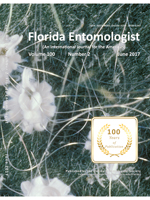The regal moth (Citheronia regalis F.; Lepidoptera: Saturniidae) is reported for the first time feeding on foliage of the American smoketree (Cotinus obovatus Raf.; Anacardiaceae), an endemic tree with a relictual distribution on calcareous soils in the southern United States. This record constitutes the third lepidopteran species known to feed on this rare tree in a natural setting.
The regal moth (Citheronia regalis F.; Lepidoptera: Saturniidae) was historically distributed in eastern North America from southern New England and southern Michigan, south to southern Florida, and west to eastern Nebraska and eastern Texas (Tuskes et al. 1996; Lotts & Naberhaus 2016). Populations in New England apparently have been extirpated (Tuskes et al. 1996; Wagner 2012). The polyphageous larvae, commonly known as the hickory horned devil, are most often encountered on host plants in the Juglandaceae—hickories (Carya spp.), pecan (Carya illinoinensis [Wangenh.] K. Koch), black walnut (Juglans nigra L.), and butternut (J. cinerea L.). Other frequent host plants include persimmon (Diospyros virginiana L.; Ebenaceae), sweetgum (Liquidambar styraciflua L.; Altingiaceae), and sumac (Rhus spp.; Anacardiaceae) (Tuskes et al. 1996; Heppner 1999). Occasional native food plants include sourwood (Oxydendrum arboreum (L.) DC.; Ericaceae), common buttonbush (Cephalanthus occidentalis L.; Rubiaceae), sassafras (Sassafras albidum (Nutt.) Nees; Lauraceae), wax myrtle (Morella cerifera (L.) Small; Myricaceae), ash (Fraxinus spp.; Oleaceae), blackgum (Nyssa sylvatica Marshall; Cornaceae), oak (Quercus spp.; Fagaceae), American sycamore (Platanus occidentalis L.; Platanaceae), and willow (Salix spp.; Salicaceae) (Worth et al. 1979; Tuskes et al. 1996; Heppner 1999). Larvae have been reared in captivity on additional species of native and introduced plant species (Tuskes et al. 1996).
Here I report the first record of C. regalis feeding on the foliage of the American smoketree, Cotinus obovatus Raf. (Anacardiaceae) in Ozark County, Missouri (36.6264833°N, 92.5899333°W; 252 m above sea level) on 12 Sep 2016 at 5:30 PM. The late instar larva had eaten portions of several leaves (Fig. 1) and had entirely consumed 6 leaves, leaving only the petioles. The smoketree is a rare endemic tree with a relictual distribution comprising three localized populations: (1) on the Ozark Plateau in Arkansas and Missouri with a few scattered stations in eastern Oklahoma, (2) from the southern Cumberland Plateau in northeastern Alabama and adjacent Tennessee and Georgia, and (3) on the Edward's Plateau of south—central Texas (Little 1977; Davis & Graves 2016). All known populations occur on soils derived from calcareous bedrock, typically in glades, and on cliffs and bluffs. Opportunities for arthropod—host specialization are relatively limited given the general rarity of the smoketree and its disjunct geographic range. The Butterflies and Moths of North America database (Lotts & Naberhaus 2016) shows historic and recent records of C. regalis for only 11 of the 34 counties in which natural populations of smoketree have been documented (Davis & Graves 2016).
The proposed introduction of biocontrol agents to counter the invasive Brazilian peppertree (Schinus terebinthifolia Raddi; Anacardiaceae) in Florida (Medal et al. 1999; Manrique et al. 2008; Diaz et al. 2015) substantially raises the conservation stakes for the distantly related American smoketree (Miller et al. 2001) because no arthropod introduction aimed at the Anacardiaceae is devoid of risk. In any case, there is an urgent need to document the native and introduced arthropod pests in natural populations of smoketree. Previous to this paper, the only documented arthropod pests of smoketree were the notodontid moth, Datana perspicua Grote and Robinson (Lepidoptera: Notodontidae; Crocker & Simpson 1982), reported from a nursery plant in Texas, and the recently described gracillariid leafmining moth (Cameraria cotinivora Davis and Graves; Lepidoptera: Gracillariidae) in natural populations of smoketree on the Ozark Plateau (Davis & Graves 2016). Fieldwork was supported by the Alexander Wetmore Fund (Smithsonian Institution) and the Smoketree Trust.






